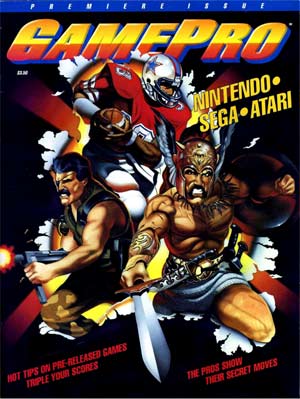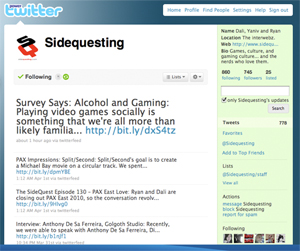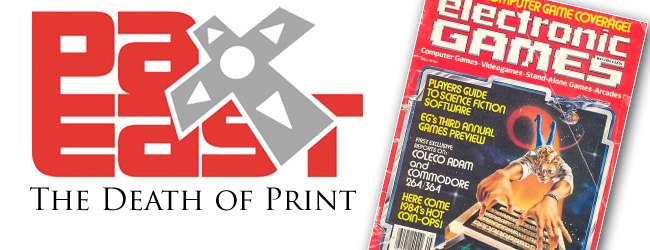One of the highlight panels at the inaugural PAX East was “The Death of Print”, mostly because of the well-known names attached to it. Russ Pitts, Editor in Chief of the Escapist, assembled a panel of print media alumni and veterans to discuss the topic of declining video game print media. John Davison (Gamepro), Jeff Green (EA, formerly EGM), Julian Murdoch (freelance journalist), and Chris Dahlen (Kill Screen) joined Pitts in speaking to the issue of changing consumer content delivery, and how print has been evolving to compensate for this change.
The title of the panel is a little misleading, as print isn’t necessarily dying… just changing. Radically. The panel discussion addressed three main points: the decline of print media, the changes needed for print to adapt and survive, and the future of the content that we consume. From the perspective of a long time gaming magazine subscriber and wannabe-journalist, this seemed like the perfect panel to attend. The topic seemed to awaken the early-nineties Electronics Boutique/WaldenBooks lurker in me, as I had been following magazines like EGM and Nintendo Power since their inception and eventual declines.
The Decline of Print Media

The opening discussion centered around the decline of the medium. Pitts opened with a question to the panel: “Is print dead?” The perspectives from the different panelists included leveraging the high cost of printing a magazine, the considerable weight of saying an article is “for print” over “for the web”, and even the cultural “cheapening” of our products.
Davison touched on his hiring at Gamepro as a sort of “phoenix rising” event. The “old” Gamepro was bleeding subscribers, centered on conservative content that readers found more readily available on the web (news, reviews, etc). When Davison was brought aboard, he quickly moved to create a paradigm shift for the magazine, instead focusing on in-depth original articles about not only gaming but the culture surrounding the hobby.
Print’s decline can be attributed to the proliferation of the web, mobile devices, and social networking. When news travels at lightning speed across Twitter and Facebook, appearing on a blog within minutes, why wait to read it in a magazine over a month later? Speed and access were the pillars of print in the past.
So much of the reason that print hasn’t disappeared yet is that there remains a considerable amount of vanity for a publisher to having their game on the cover of a magazine, adorning news stands and grocery aisles. It becomes “something that the developers can show their bosses.” Even more so, consumers still love to hold a physical object in their hands.
Print is Adapting
As noted above, several factors are attributing to the decline of the magazine. Though Murdoch noted that “we’ll never stop printing SOMETHING,” that something “will need to change.” Like Dahlen’s “Kill Screen” magazine, niche and lower print run magazines will slowly become important, even though the once million-dollar magazines will slowly fade away. A reference to the resurgence of vinyl records as a niche medium suggested that, quite possibly, gaming magazines will have to become more premium rather than mainstream as they once were.
The panelists agreed that print will need to avoid the news, much like Gamepro began to do, and focus on aspects and articles that are considered to be “premium”. A part of this is the current quantifiable quality of print over web media. The packaging of articles, design of pages, and copy editing are not prolific on the web like they are in print. There is generally more love placed into how an article appears on a page rather than in a blog post.
The Future of Content
The panelists closed with a discussion on the delineation between what content consumers prefer in print and what is better on the web.  Print, they noted, cannot keep up with the speed of the web and digital content and display of information is always accessible. Products like the iPad and mobile devices will allow print magazines to retain their relevancy by becoming more digitally “aware”. Beyond websites, this includes replicating magazines in unique and accessible digital formats that might mimic the experience of reading well-edited print.
Print, they noted, cannot keep up with the speed of the web and digital content and display of information is always accessible. Products like the iPad and mobile devices will allow print magazines to retain their relevancy by becoming more digitally “aware”. Beyond websites, this includes replicating magazines in unique and accessible digital formats that might mimic the experience of reading well-edited print.
Online information will center on instantaneous news and opinions, while print (and its step into digital) will feature articles, interactive media, and fact-checking journalism.
Murdoch noted that the future of print is “the ten minutes before the plane takes off”, when electronic devices are usually asked to be turned off. This reference, although somewhat pessimistic, implies that print will be relegated to specific situations and not the anywhere, any time medium that it has been in the past. We’ll be reading magazines in coffee shops on e-readers, not on paper.
Overall, the panel was highly successful, although I would have liked to hear more of the panelists opinion of what non-gaming magazines are doing it right, and how that can translate into reporting on video games in print and in bettering the web experience. The panel consisted of individuals with well-known personalities and an incredible passion for video games and, like I mentioned in our Online Communities write-up, would have benefited from a little more time.



1 Comment